Key takeaways:
- Reparations politics involves acknowledging historical injustices and their impact on present-day communities, emphasizing dignity and cultural restoration.
- Effective protest planning requires clear messaging, community engagement, and logistical preparation to ensure participant involvement and a cohesive narrative.
- Storytelling and personal narratives enhance emotional connections and can significantly amplify the effectiveness of a protest’s message.
- Sustaining momentum post-protest is vital, necessitating ongoing dialogue, partnerships, and specific goals to maintain community engagement and advocacy efforts.

Understanding reparations politics
Reparations politics is a multifaceted discussion that delves deeply into historical injustices and their lingering effects on communities today. When I first got involved in activism, I was struck by how often the past informs our present. It raised a thought for me: how can we truly heal without acknowledging and addressing the wounds of history?
I remember attending a town hall meeting where a passionate speaker outlined the economic disparities faced by marginalized communities due to systemic racism. Listening to their life story made me realize the emotional weight of reparations. It isn’t just a financial transaction but a recognition of dignity and worth—a chance for society to say, “We see you, and we are here to make it right.”
Moreover, I often ponder how often we view reparations strictly through a financial lens. Isn’t it also about the restoration of culture, community, and pride? As I reflect on this, I see the potential for reparations to go beyond money, encompassing education and acknowledgment. It makes me believe that understanding reparations politics requires a broader lens—one that captures not just what was lost, but what can be rebuilt.
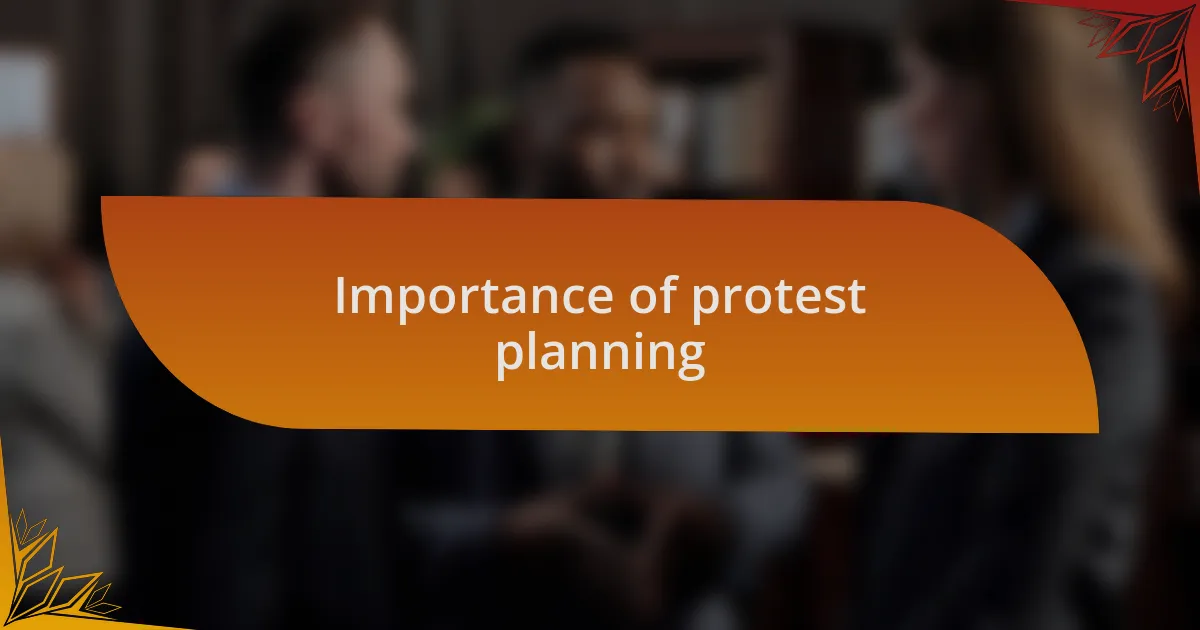
Importance of protest planning
Proper protest planning is crucial for amplifying the voice of a movement. From my experience, knowing your audience and your message can significantly shape the impact of your protest. I’ve participated in events where a lack of clear objectives diluted the message, leaving attendees confused about the cause.
In another instance, I witnessed firsthand how meticulous planning can rally community support and participation. Organizing logistics, such as choosing an accessible location and coordinating speakers, made everyone feel included and valued. It made me realize that when participants see their needs addressed, they are far more likely to engage wholeheartedly.
During one protest I was involved in, we had a designated area for storytelling, allowing individuals to share their experiences with reparations. This personal touch not only educated attendees but also fostered emotional connections, reinforcing the importance of understanding the issues at stake. It taught me that protest planning isn’t just about logistics; it’s about weaving together the narratives that resonate with people, creating a powerful collective voice for change.
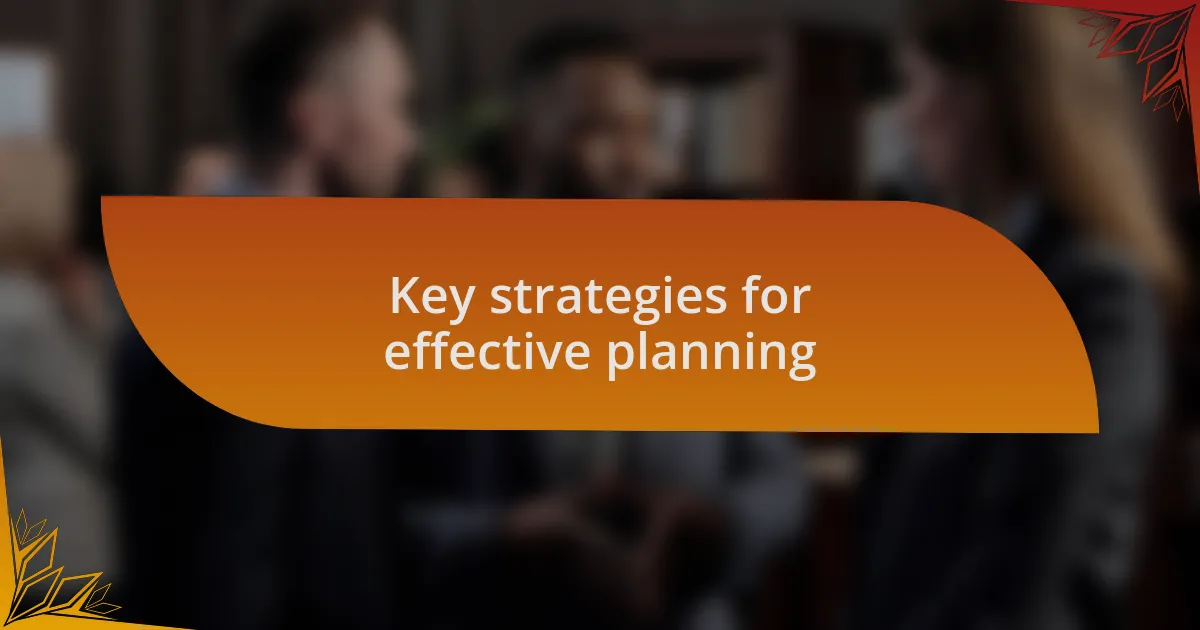
Key strategies for effective planning
Effective protest planning requires a clear vision and a well-defined message. In one of my earlier protests, we spent hours brainstorming our core message, which allowed us to create impactful signage and speeches. It’s fascinating how clarity in communication attracts attention. Wouldn’t you agree that when a message resonates with people’s experiences, it has a stronger chance of sparking action?
Logistics can make or break a protest. I once attended an event where last-minute venue changes led to a chaotic atmosphere, and many participants felt lost. Planning for every possible scenario is vital; having a contingency plan ensures that you can adapt while maintaining a sense of purpose. Think about it: wouldn’t a well-organized protest inspire more community members to participate actively and feel empowered?
Building a coalition of diverse voices enhances the strength of a protest. I remember collaborating with local artists and activists, and together we developed creative ways to engage the crowd. This approach not only broadened our reach but also highlighted the multidisciplinary nature of the movement. When different perspectives come together, they enrich the narrative, don’t you think? It’s undeniable that inclusivity in planning fosters a deeper connection among participants, ultimately amplifying the movement’s message.
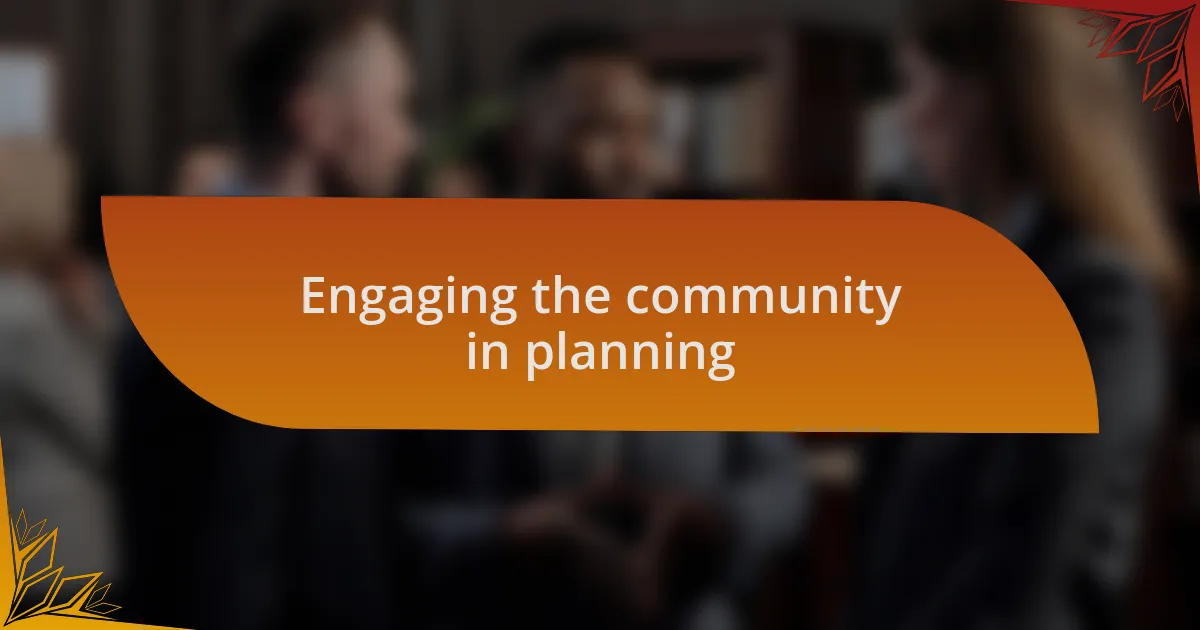
Engaging the community in planning
Engaging the community in the planning process is not an option; it’s a necessity. I recall a neighborhood meeting where we invited residents to share their ideas for an upcoming protest. The energy in the room was palpable, as everyone brought unique perspectives and experiences to the table. Isn’t it amazing how a single shared vision can spark such enthusiasm in a diverse group?
One of my most memorable experiences involved creating a community advisory board for a protest initiative, where participants felt a genuine sense of ownership over the event. It was enlightening to see how their insights shaped our strategies and messaging. The conversations sparked creativity, leading to ideas I would never have considered on my own. Have you ever noticed how collaborative environments can lead to unexpected breakthroughs?
Ultimately, showing community members that their voices matter cultivates trust and loyalty. When I included community members in the decision-making process for logistics, it transformed our approach. They took pride in the success of the event, which fostered a deeper connection to the cause. Don’t you think that when people feel heard, they’re more likely to stand by the movement?
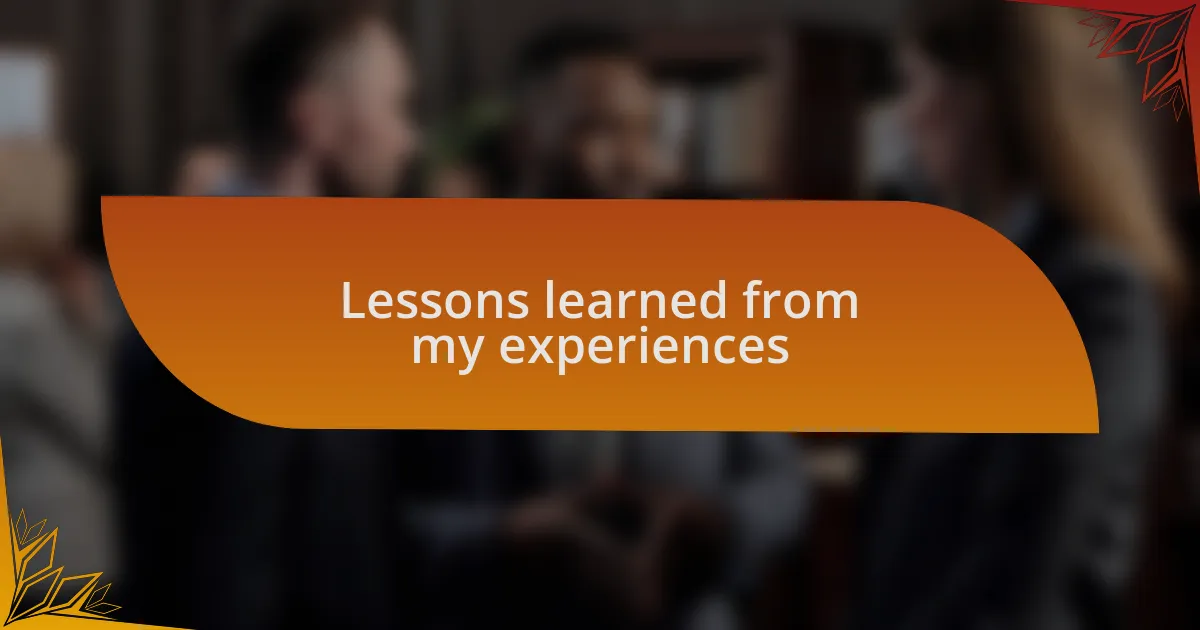
Lessons learned from my experiences
In my journey of planning protests, I learned the value of adaptability. During one event, we faced unexpected changes, from speakers dropping out to weather issues. Instead of panicking, I realized we needed to pivot quickly. This taught me that resilience often comes from embracing the unknown with a positive mindset. Have you ever felt the thrill of turning a setback into an opportunity?
One lesson that stands out for me is the importance of storytelling. While collaborating with community members, I discovered that their personal narratives resonated far more than any statistics could. I recall a participant who shared her family’s history and struggles; her story became the centerpiece of our messaging. Isn’t it fascinating how authentic narratives can deepen emotional connections and amplify a cause’s impact?
Furthermore, I learned that effective communication is paramount. In one instance, I underestimated how important it was to keep everyone updated on changes leading up to a protest. The confusion among team members highlighted my oversight. Remember, clear communication isn’t just about relaying information; it’s about building a cohesive unit driven by a shared purpose. How do you ensure everyone’s on the same page in your efforts?
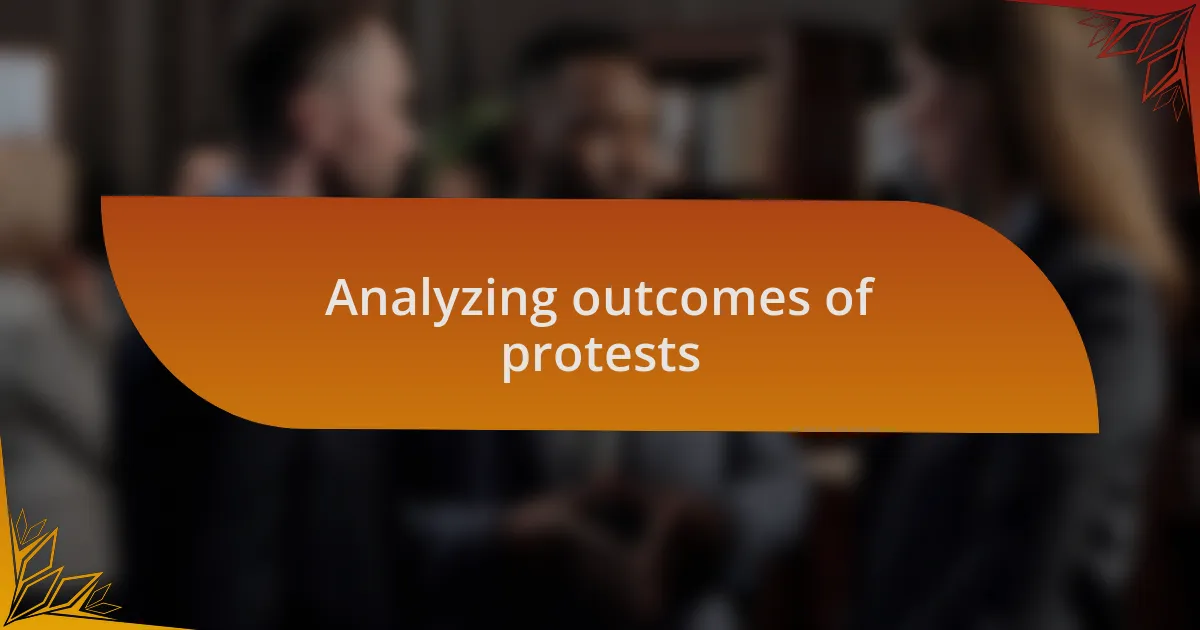
Analyzing outcomes of protests
When analyzing the outcomes of protests, I often reflect on the immediate response they generate. In one instance, our march garnered attention from local media, which led to a rapid increase in community engagement. This reaction reinforced my belief that the visibility created by protests can be a catalyst for change. Have you witnessed how a single event can ignite dialogue in unexpected ways?
Beyond media attention, I’ve seen that protests can also lead to tangible policy discussions. During a particularly impactful demonstration, I noticed government officials paying attention to our demands, initiating conversations that hadn’t happened before. This moment taught me how our voices can influence decision-makers and shape policy. Isn’t it remarkable to see how collective action can push issues to the forefront of political discourse?
Finally, I learned that the aftermath of a protest often shapes its legacy. One protest, for instance, prompted follow-up community meetings that turned into a series of ongoing dialogues about reparations. These continued discussions highlighted the need for sustained engagement beyond the event itself and illustrated that the real work often starts after the protest is over. How do you think we can maintain momentum after such pivotal moments?
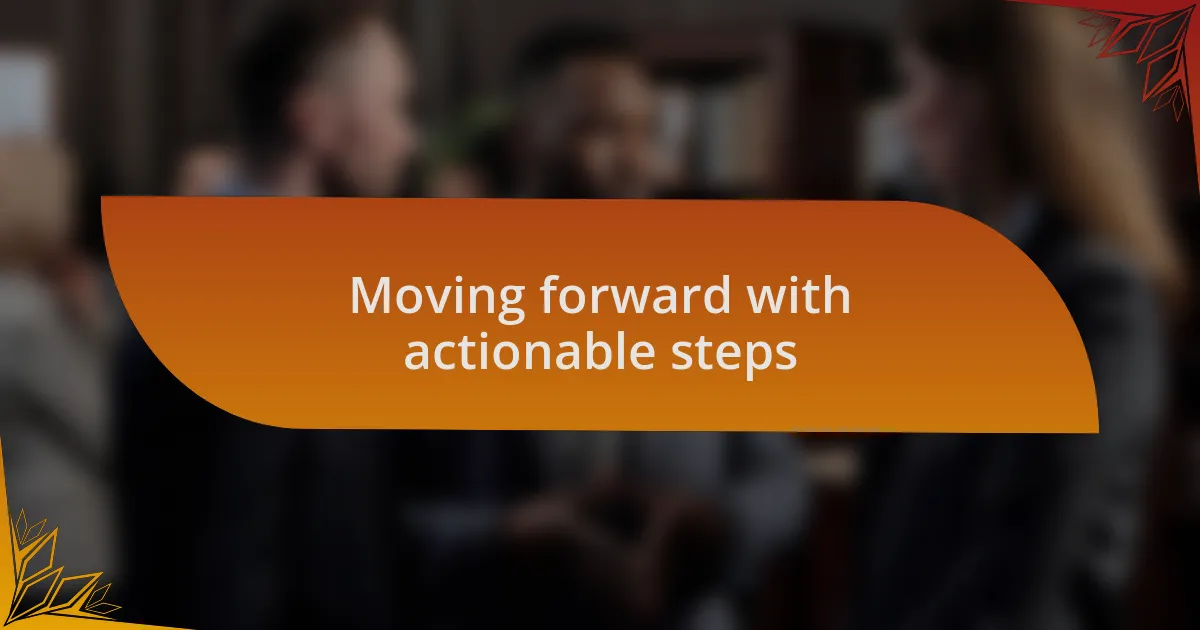
Moving forward with actionable steps
When it comes to moving forward with actionable steps, I’ve found that establishing clear goals is essential. After one protest that I organized, our team gathered to outline what we wanted to achieve—whether it was increasing awareness about reparations or influencing local government decisions. This reflection made me realize that without specific aims, it’s all too easy for momentum to dissipate. Have you ever felt the frustration of having energy dissipate without a clear direction?
In my experience, fostering ongoing partnerships is crucial. I remember connecting with local organizations after a protest; this collaboration expanded our outreach efforts, allowing us to engage diverse community voices. It was eye-opening to see how pooling resources and knowledge strengthened our advocacy. When alliances are formed, collective power grows. How can we actively seek these partnerships in our communities?
Lastly, I believe we must keep the conversation going, even after the initial fervor of a protest. Following one significant event, I took it upon myself to organize weekly discussions that encouraged everyone to share ideas and strategies. These gatherings not only maintained our momentum but also deepened our understanding of the issues at hand. How important do you think it is to create spaces for continued dialogue? Through these interactions, I’ve seen firsthand how they can keep our collective vision alive and actionable.